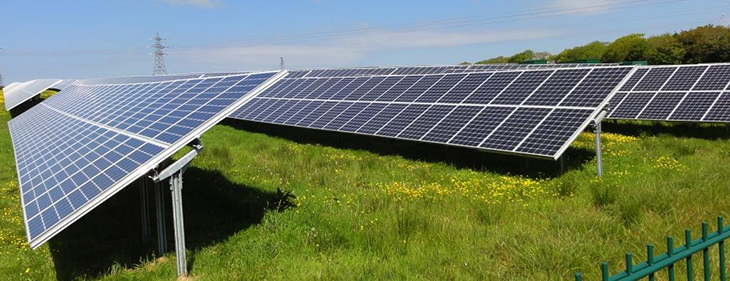 Loading... Please wait...
Loading... Please wait...- Home
- Solaris Blog
- Best Practices for Commercial Solar Arrays
Products
- Solar Panels
- Solar Panel Kits
- Solar Generators
- Inverters
- Inverter Monitoring
- Inverter Accessories
- Balance of Systems
- Racking and Mounting
- Rails
- Flashings
- Splice Kits
- Stopper Sleeves
- Conduit Mounts
- Attachments
- Brace Assembly
- Base Mount
- Brackets
- Bolts
- Clamps
- Caps
- L-Feet
- Washers
- Skirt
- Lugs
- Tilt Legs
- Hooks
- Stand-Offs
- Ballast Bay
- Top of Pole Mount
- Side of Pole Mount
- Flush Mount Kits
- Ground Mount Kits
- Roof Mount Kits
- Hardware Packages
- Wire Management
- Batteries
- Battery Accessories
- Charge Controllers
- Tools and Supplies
- View All Products
Best Practices for Commercial Solar Arrays
Posted by Brandi Casey on 28th Mar 2017

Commercial solar arrays are typically designed and sized in the same manner as residential systems. However, there are a few notable differences between the systems that are worth keeping in mind when you begin to size a commercial array.
Due to the size of the system, business owners prefer systems that blend into the environment. Installers should note client aesthetic preferences when determining the correct solar panel to match the system. Although this step isn’t commonly thought about when looking through specifications sheets for solar panel sizing, voltage and so on, it should be noted and will let your client know that you have their individual needs in mind.
Along with the idea of aesthetics comes functionality. In the large majority of residential arrays, the solar panels are mounted on the homeowners’ roof. However, in commercial arrays, a ground mount system may be the better option. Systems of a commercial size are most likely to be bulky and heavy. Proposing a ground mount installation will save the business owner time and concern over the stability of their roof structure and possibly save them from costly roof alterations. For flat roofs, ballast bays can weigh up to thousands of pounds and will certainly require a great deal of permits and inspection prior to design approval. If your client has the land to accommodate the system, then a ground mount may be the best alternative.
In terms of the solar module itself, efficiency is key. Highly efficient modules will ensure that the commercial array works to is maximum potential. With the rise in high efficiency and watt modules, the options for the commercial array are vast. Using high watt modules decreases the number of solar modules needed for the project, but saves cost in modules and shipping as well. A lesser number of modules will also decrease the number of racking pieces you will need and save costs as well. It is not uncommon for solar manufactures to produce highly efficient modules above 300 watts in today’s market. Some of the top high efficiency modules are Canadian Solar, SolarWorld, Trina Solar, Panasonic and Hanwha Q Cells. Each offers a wide array of modules with high efficiency, wattage and a number of style combinations.
A commercial inverter is also a necessity for any commercial project. Typically, for larger systems it is best to use three phase inverters in place of one phase inverters to ensure maximum energy yield. Some projects may benefit from the use of microinverters, however keep in mind that microinverters typically add to project cost. However, microinverters are known to have a warranty that is double that of a string inverter. Microinverter manufacturers such as Enphase and APsystems have taken note of the increase in module wattages, and have responded with introducing microinverters that can handle 72 cell modules. Business owners may see the benefit of using microinverters to save on future costs. Efficiencies between modules and microinverters must be calculated to see if the energy output will maintain or better the projected ROI.
Commercial projects are not only beneficial to business owners, but communities. As more businesses become green, the demand for solar continues to rise. Keeping your clients’ needs in mind when taking on large scale projects is key and savings on project costs can ensure that you earn the winning bid for the project. Be sure to check local regulations in commercial markets as they may vary from residential applications. This research will further assist you in saving project costs and determine which solar module, racking system and inverter is best for the project.



